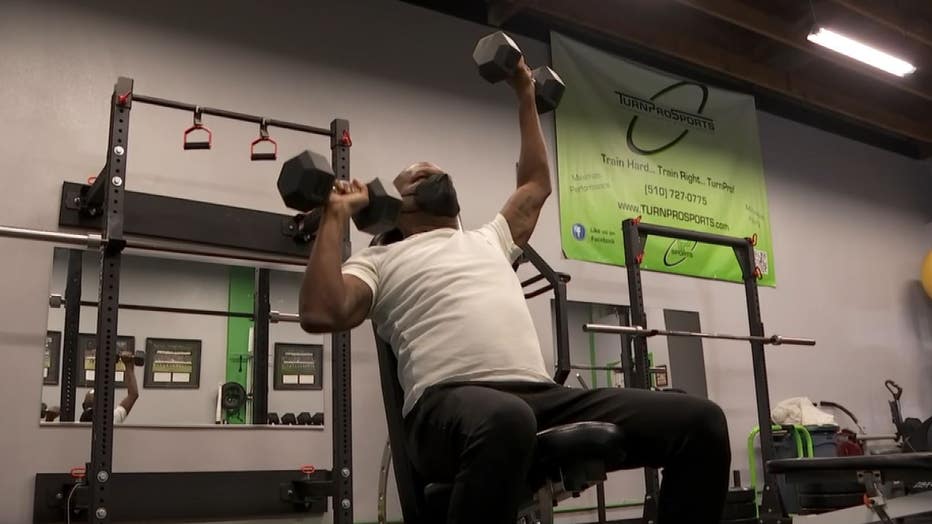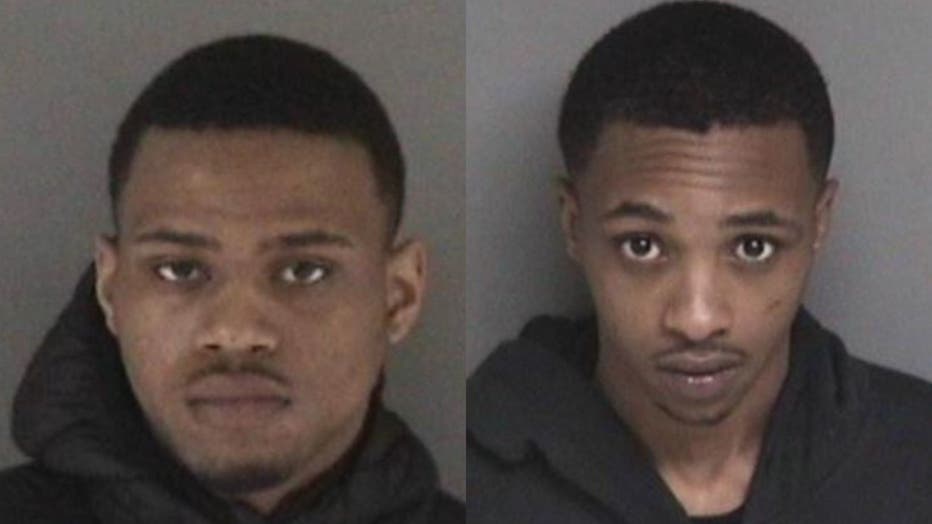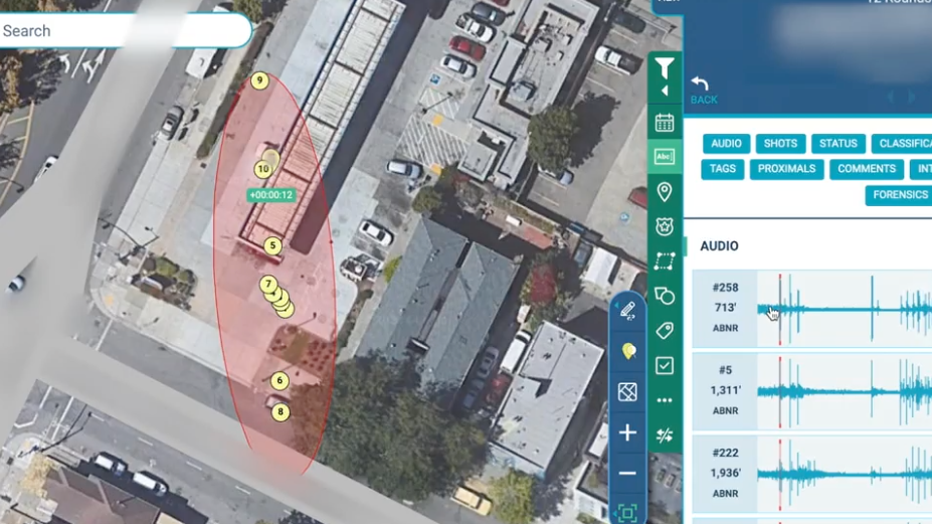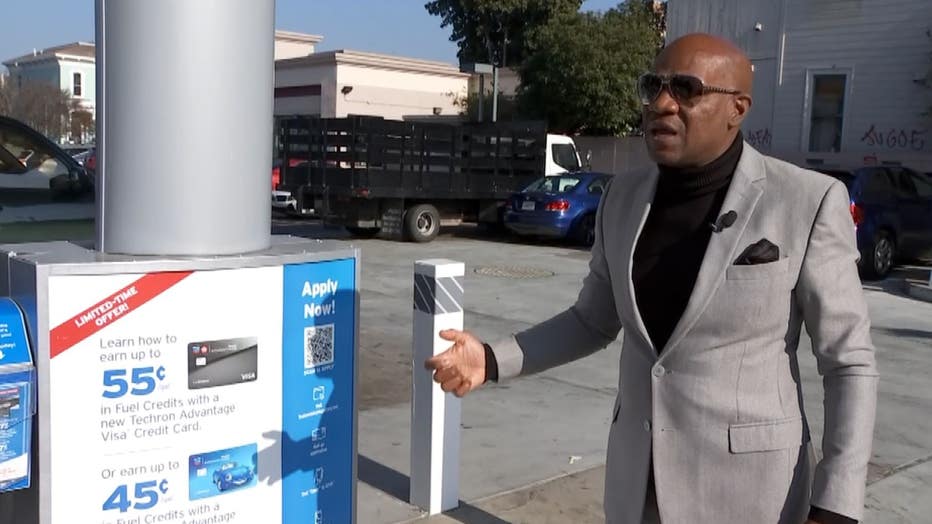Ersie Joyner 'humbled and humanized' after surviving 22 bullet wounds in Oakland shootout

EXCLUSIVE: Ersie Joyner details surviving 22 bullet wounds
In an exclusive interview, retired Oakland Police Capt. Ersie Joyner describes a fatal armed robbery where he killed a man and ended up surviving 22 bullet wounds. Andre Senior reports
OAKLAND, Calif. - Ersie Joyner III pumps his arms on the treadmill and rolls his hips on a foam roller. He lunges. He extends his body into a plank, crunching his knees to his chest. He pumps dumbbells into the air.
"Let’s get it!" Joyner shouts with a clap. "Whoo!"
It’s no small feat that the 52-year-old retired Oakland police captain is working out at this Hayward gym with his trainer, who also happens to be an associate pastor with whom he studies the Bible every week.
Joyner’s body was pierced with 22 bullet wounds after being shot by four men who also grabbed his necklace, cash and watch while pumping gas at the Chevron station at 17th and Castro streets in the middle of the afternoon on Oct. 21. He also ended up killing one of his attackers.
Three months later, all that really hurts now, Joyner said, is his pinky finger, which stiffens up when it gets cold.
Joyner is grateful but matter-of-fact about his miraculous recovery.
And in an extensive, exclusive interview this week with KTVU, Joyner described the most traumatizing day of his life for the first time. One that has changed his outlook forever.
"I’m just happy to be alive," Joyner said. "I thought I was going to die several times. I thought for sure this was it. I want to glorify God in his greatness, and it’s His grace that I survived that."
BONUS VIDEO: Ersie Joyner describes the moment he was shot
But it’s not just God.
It’s also the hard work that Joyner has put in to rehabilitate his body and his mind. The moment his body cast came off six weeks ago, Joyner hit the gym.
"I hate it when I come in," Joyner said, breathing heavily after his workout. "But I love it when I leave."
Trainer Chris Pearson said Joyner’s determination has never wavered.
"He is a competitive individual," Pearson said. "When you tell him he can’t, that’s the wrong thing to do. He’s going to accomplish whatever it is."
Despite all the bullet holes, Joyner has no visible limp, even though his ankle has four wounds alone, as pieces of metal tore through body. He doesn’t wince in pain when he sits or stands, even though he has three bullet wounds near his spine. Bullets also left entry and exit wounds in his torso, his back, his thighs and his big toe. One bullet is still lodged in his back.
But Joyner looks as dapper as ever now, looking trim and fit in a black turtleneck and smartly fitted Versace suit.
Still, Joyner said he’s not quite the same as he used to be.
"I’m getting stronger," he said. "I’m almost there."

Ersie Joyner lifts weights at TurnPro Sports in Hayward. January 2022
A day gone sideways
On the day he was ambushed, Joyner acknowledges that he had let his guard down.
He said he was too busy looking at the Southwest Airlines app on his phone.
He was trying to get to the Oakland airport to make a flight to Southern California for one of his consultant gigs.
Since he retired in 2019 from the Oakland Police Department after a 28-year career, Joyner now consults with various police departments on how to improve their violence prevention programs. He also aids the cannabis industry to make sure they are compliant with safety procedures. He’s also called in as a police expert to work on writing and producing TV shows.
On this particular afternoon, Joyner hadn’t been surveying his surroundings while filling up his white Porsche SUV at the pump.
So he missed the black sedan roll up with four men inside just about 1 p.m.
"This particular day, I was so engrossed with everything else," he said, "I didn’t even see the car pull into the gas station, which if I had, would have been a totally different outcome."
In his first public interview, Joyner described in detail what happened that day. Many have seen the 60 seconds of surveillance video from the gas station that showed three men in hoodies rifling through his pockets.
But this is the first time that Joyner has publicly filled in the blanks.
A man with a full ski mask approached him.
"Give me everything," the man demanded.
A second gunman appeared. He immediately grabbed Joyner’s necklace. Joyner instinctively reached for his jewelry to prevent it from breaking. The man swore at him, telling Joyner that he’d shoot. Someone pointed a gun at his belly.
"Here man, it’s yours," Joyner recalled saying.
"I just didn’t want it to break," he explained to KTVU.
BONUS VIDEO: Ersie Joyner describes how the armed robbery went sideways
A third gunman appeared. He tried to pull Joyner’s watch off his wrist. Another man reached for Joyner’s bracelet. The third man started rifling through Joyner’s pockets.
Joyner’s compact Glock 43 was tucked on the right side of his pants. He is permitted to carry a concealed weapon, but he knew if the robbers found it, things would escalate quickly and get out of control.
"I immediately started thinking to myself about contingency plans," Joyner said.
Joyner said he was fully cooperating with these men. He was talking slowly and calmly. But he said he realized that no matter what he did, or what he gave them, things were not going to end well. He realized his options were running out.
Moments later, the men reached into Joyner’s pockets, he said, and pulled out some cash. That seemed to placate them, but they wanted more. Joyner offered them the luggage in his SUV, but when they couldn't find it tensions only escalated.
"F– that N----!" one of the men yelled at Joyner.
Then to his friends: "Shoot him and take his truck."
This was at least the seventh time that he had heard the men say something like "shoot him" during the encounter.
Joyner could see that the men were holding handguns. And he felt that he couldn't risk doing nothing anymore.

ShotSpotter technology may have helped save Ersie Joyner's life
ShotSpotter, a gun detection technology company based in Oakland, may have helped save retired Oakland Police Capt. Ersie Joyner's life by sending officers to a shootout before anyone called 911. Andre Senior reports.
Joyner shoots first
Joyner shot first. He fired 10 times, emptying his magazine.
Joyner has heard people question his decision.
"I respect people having their opinions," he said. "And I don't expect everyone to agree. I don't mind being challenged. But I had exercised restraint. But in the end, after 29 years of experience, I felt that I had to protect my life."
The men returned fire.
Joyner was shot at least nine or 10 times, he believes. He said the doctors don’t know for sure. What he does know is that a total of 22 bullet holes were created in his body.
"They can’t tell me how many times I was shot because many of them are through-and-through wounds," Joyner said, pointing to his thighs for example, where the bullet entered and exited the outside and inside of both his legs for a total of four holes.
During and after the shooting, Joyner – two years into retirement – was in full cop mode.
From the ground, he asked witnesses at the scene to call police, but he says he couldn't hear anyone calling 911. He commanded arriving officers to take the keys out of his truck and secure the scene.
"And for a split second, I had to remind myself, man, you’re a civilian," he recalled. "And here you are giving orders. You need to slow your roll. But I just needed the help."

GRAPHIC: Surveillance video shows deadly shootout between attempted robbery suspect and retired OPD captain
Warning: Some viewers may find this content disturbing. The video comes from the Chevron gas station where the incident unfolded Thursday afternoon.

Marlon King (pictured left) and Kemandre King (shown right).
Suspect killed during shootout
In the end, Joyner later learned he had killed Desoni Gardner, 20, a Vallejo rapper, also known as Lil Theze.
The other three men – brothers Marlon Julius King and Kemandre Jacoby King and getaway driver Joshua Hayles – did not suffer any major injuries, though Joyner thinks he grazed one of them.
All three were charged with second-degree robbery as well as murder. All three are scheduled to enter a plea on Feb. 8.
In a small twist of irony, the same Ceasefire team of police officers that Joyner helped lead for seven years ended up tracking down the suspects.
Even though Joyner was the one who actually shot the gun that killed Gardner, the Alameda County District Attorney used what is known as the "provocative act doctrine," which allows a crime victim to use "justifiable lethal force" against his or her attacker.
The DA is not pursuing any charges against Joyner. To this day, police and prosecutors have said there was no prior connection with the suspects.
"It was a happenstance, chance contact," Joyner said, saying he was told nothing about his prior work as a police officer or current cannabis consulting could be connected to this brazen attack.

The surgeon who wouldn't let Ersie Joyner say goodbye
Highland Hospital's Dr. Timothy Browder would not let retired Oakland Police Capt. Ersie Joyner even think about saying goodbye, despite being shot up with 22 bullet holes. Andre Senior reports
A coincidence a decade in the making
As Joyner lay on the concrete with bullets riddled in his body, he was keenly aware that he needed medical help and he needed police to show up fast.
Whether it was by design or fate, both arrived quickly.
Both he and his friend, Ralph Clark, who happens to be the CEO of ShotSpotter, believe that the gun detection technology employed by Oakland police was key to Joyner’s survival.
The two men became acquainted more than a decade ago through their daughters who played soccer together. And soon, their personal lives blended into a professional one.
ShotSpotter had had its share of criticisms and complaints across the country, including privacy issues and the occurrences of false alarms.
Clark took over ShotSpotter in 2010, at the urging of his old friend Joyner, and worked on addressing some of those complaints. Clark said he improved the technology and accessibility for police to know in moments when and where gunshots are being fired. Based in Oakland, ShotSpotter is now in 120 cities across the United States.
Clark, who was on his way to Seattle the day Joyner was shot, immediately got a ShotSpotter alert that day that multiple rounds had been fired in the middle of the day. He knew the shooting would be bad. He just didn’t know how bad. And at the time, he had no idea his friend was the one who had been riddled with the bullets that his own system was detecting.
According to Joyner, police arrived before any human had called 911; a phenomenon that Joyner has studied and lamented, especially in the neighborhood of 82nd Avenue and Birch Street, which has earned the unfortunate nickname of the "Killing Fields."
In that neighborhood, Joyner noticed that community members only call police 11% of the time, which means to him, that people think police don’t care about them enough to call, or they’ll be retaliated against if they do.
He wanted that to change.
The ShotSpotter technology takes some of those human foibles out of the equation, and according to the company, ended up saving about 100 lives last year because of the immediate police dispatch to precise locations.
Joyner says he never lost consciousness and saw Oakland police cars roll up quickly, despite not hearing any witnesses call police.
"I was really grateful," Clark said. Shortly after Joyner had been shot, his daughter texted him. "Hey thank you so much, Ralph," she wrote. "We think ShotSpotter might have played a role in saving my dad's life."

ShotSpotter gun detection system picked up nine shots fired on Oct. 21, 2021, where Ersie Joyner was shot and his attacker killed.
The surgeon who wouldn't let him say goodbye
Police threw Joyner in the back of a squad car and rushed him to Highland Hospital, one of the country’s premier trauma medical facilities.
That's when he began to feel the pain. Hot, shooting stakes of fire tearing through his entire body. He could feel the blood filling up in his torso. He couldn’t take it anymore.
He felt like he could no longer breathe.
"I looked to my right and I said, ‘Excuse me, ma'am, are you in charge of oxygen? I need oxygen,’" he recalled saying to a nurse.
He felt that he was in good hands.
"Some of the greatest medical people known to the United States were in there immediately rendering aid IVs, giving me blood because I was going to need a blood transfusion and doing all the things that they do as far as getting my vitals and trying to stabilize me at that particular moment," Joyner said.
At one point, a voice boomed out.
"Everybody back up, we’re going into surgery."
Just then, Dr. Timothy Browder leaned down into his ear.
"I got you," Browder said. "I’m going to take care of you."
In an interview with KTVU, Browder recalled that Joyner was sweating and in shock.
"He obviously was in distress," Browder said. "Once I got close, I saw the holes all over his body."
Browder said mortality rates are often high when patients come in with so many gunshots.
But he also thought in this case, Joyner would make it. The doctor quickly assembled the team.
"We're an excellent trauma center," Browder said.
Still, Joyner was worried. He hadn’t had time to reach out to his family to tell them he loved them, and possibly say a final goodbye.
Browder wouldn’t let Joyner talk or think that way.
"You’re going to tell them yourself," Browder told Joyner as he lay on the surgery table. "That’s the last thing I remember."
When he awoke, Joyner said Browder was by his side, telling him that everything was going to be OK.
Joyner stayed at Highland for nine days. He was released the day before Halloween.
"They patched me up and I’m back to new," he said.

Ersie Joyner returns to the Chevron where he was shot on Oct. 21, 2021.
‘A war for the community’
Despite spending much of his three-decade career working to reduce gun violence in Oakland, Joyner says it's ironic and traumatic that he became a victim that day.
But he's grateful his life was spared, and he didn't become one of the especially high number of homicides the city saw last year – 134.
Like Joyner’s, some of the shooting deaths were in broad daylight, like when Eric Davis was killed at Lake Merritt while trying to stop a car burglary.
Oakland is far from isolated in this crisis. Nearly every major U.S. city has seen large surges in homicides since the pandemic, an increase that’s continued into 2022 as economic inequalities widen and gun sales soar.
And Joyner himself is no stranger to violence. During his career with OPD, he was involved in five police shootings – the most of any officer. He was cleared of all wrongdoing. He led the homicide team. He was an undercover narcotics officer. He faced murderers and thieves and rapists. He’s had guns pulled on him too many times.
But now, Joyner said that he feels things are worse than normal.
"Yes, Oakland is going through an enormously high rate of violence," he said. "It’s close to unprecedented. The only way to put an end to it is come together and say ‘Enough is enough.’"
And even though Joyner is no longer with the department, he hopes Oakland goes back to pre-pandemic times, when programs such as Ceasefire can bring social services and spirituality to the criminal offenders who are at the most risk to cause harm. Pastors, social service agencies and police officers worked with the small group of offenders, or would-be offenders, in a one-on-one capacity to help change their lives with an approach other than simply throwing them behind bars.
Under Joyner’s leadership, the combined homicide rate and shootings in Oakland from 2012 to 2019 dropped nearly 50 percent.
But during the pandemic, the Ceasefire program began to fall apart.
"You know, going out and using intelligence, using data to identify people who are engaged in violence and then instead of trying to use enforcement as the first tool but engaging them in a way to tell people that we care about them, we love them, we want to see them alive and free," Joyner said. "That's the way that we should move forward as a society and law enforcement."
Joyner said he still loves the city that he grew up in and tried to change for the better. Despite what’s going on in Oakland, he loves it and has no plans to leave.
"I can move out of Oakland," he said. "I can go buy a house somewhere else. But I’ve always wanted to be here. I’m going to serve this community, not just by serving it but by being in the community. I’m loyal to the soil."
Even in law enforcement, Joyner said he felt his fight was not against the community but was "a war for the community."
"Then becoming a gunshot victim and being at the other end of a robbery and a shooting was traumatizing," he said. "It was unbelievable. I've always thought that I was invincible. I got humbled and humanized on that day on October 21st. That's for sure."
Forever changed
Joyner isn’t exactly back to new.
The veteran officer said he has changed.
"It’s a situation that was very traumatic for me," he said.
He said that he is now more hyper-vigilant than ever. Going to the grocery store, filling up with gas are no longer done in a laissez-faire manner.
He recently left a car wash before his fourth wheel was cleaned after he saw four men in hoodies and ski masks drive up to the lot.
"I was so uncomfortable, I left before they finished," he said. "I find myself taking a deeper, harder look at people dressed the same way as the guys who robbed me."
And he said he's never going to fill up with gas at that particular Chevron station again.
And he has some minor regrets.
"I really regret this entire incident happened," he said. " I regret the fact that I didn’t see the car."
He also wonders now if he should have retreated behind his truck for cover.
But he also knows that he can’t Monday-morning quarterback a situation where he ended up alive.
He doesn’t lay awake at night worrying. He doesn’t second-guess his decision to pull the trigger.
"I stand behind everything I did," he said – a direct reference to having killed a young man, despite some criticism in the community that he could have considered non-lethal alternatives.
He also wants to share his story, hoping that his tale will inspire others to not give up.
"I want to make sure that people know that you have to fight for your life," Joyner said. "You cannot just be a victim. You have to be a survivor."
KTVU photographer Tony Hodrick contributed to this report.
Lisa Fernandez is a reporter for KTVU. Email Lisa at lisa.fernandez@fox.comor call her at 510-874-0139. Or follow her on Twitter @ljfernandez

